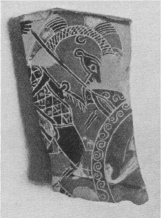No CrossRef data available.
Article contents
An Attic Black-figure Cup-fragment
Published online by Cambridge University Press: 23 December 2013
Extract
Fig. 1 is a fragment in a private collection in England. It is said to have been found on the Acropolis of Athens, and Mr. Payne points out to me that it joins a fragment in the Acropolis collection, Graef 1780, pls. 83 and 87, with the inscription χ]ειρον εποιε[σεν. The vase was a Siana cup with overlap decoration. Red is used for the helmet, the second and fifth sections of the crest, and the inside of the Boeotian shield; white for the fifth, fourth and last sections of the crest, spots and stripes on the cuirass, the arm-strap and the shield-device, a seated lion or sphinx with one paw raised. The contours are incised, except for the upper edge of the Boeotian shield. In front of the crest is the end of a black line; it is too close to be part of the other warrior's crest and is not incised; probably it is the beginning of an inscription, no doubt the warrior's name. The painter has carelessly transferred to the upper part of the rim of the Boeotian shield the pattern belonging to the round one.

- Type
- Notes
- Information
- Copyright
- Copyright © The Society for the Promotion of Hellenic Studies 1935
References
1 The third surviving letter is badly formed, and the inscription is variously restored: by Benndorf, Gr. u. Sicil. Vasenbilder, pl. 12, 5, Χ]ειρον εποιει, improved by Klein, , Meistersign. ed. 2, p. 216Google Scholar, to εποιε]σεν. Meier, P. J., AZ 1884, p. 239Google Scholar, wished to read Χιρον, and identified him with the potter of an unpublished Little Master cup without figure decoration once in the Vatican but since lost. The first surviving letter is certainly ε, but the identification is perhaps possible even reading Χ]ειρον. See, however, Beazley, , JHS 52, pp. 192, 200Google Scholar. Graef reads φ]ειδον εποιε[σεν. There is no other δ in the painter's inscriptions, but the one ρ closely resembles this: no. 64 in the list of his works, Graef, 1613, pl. 82, Ευρυ retrograde.
2 On the shape see JHS 49, p. 260, 51, p. 275Google Scholar; Metr. Mus. Stud. V, p. 93Google Scholar.
3 For a discussion of the painter's style and a list of works from his hand and school see Beazley, in Metr. Mus. Stud. l.c. pp. 93 ff.Google Scholar
4 JHS 5, pl. 43; CVA B.M. II, pl. VIII, 1.
5 Metr. Mus. Stud. l.c. fig. 21.
6 Ib. fig. 20; MonAnt 22, pl. 57.


